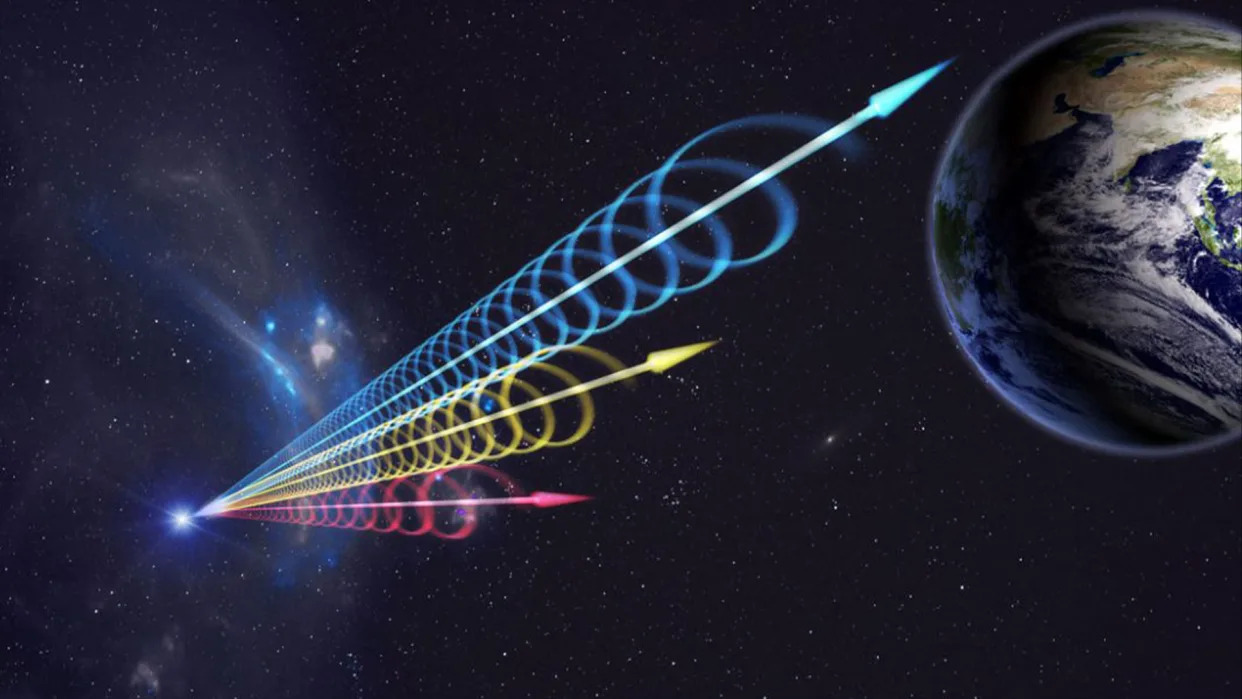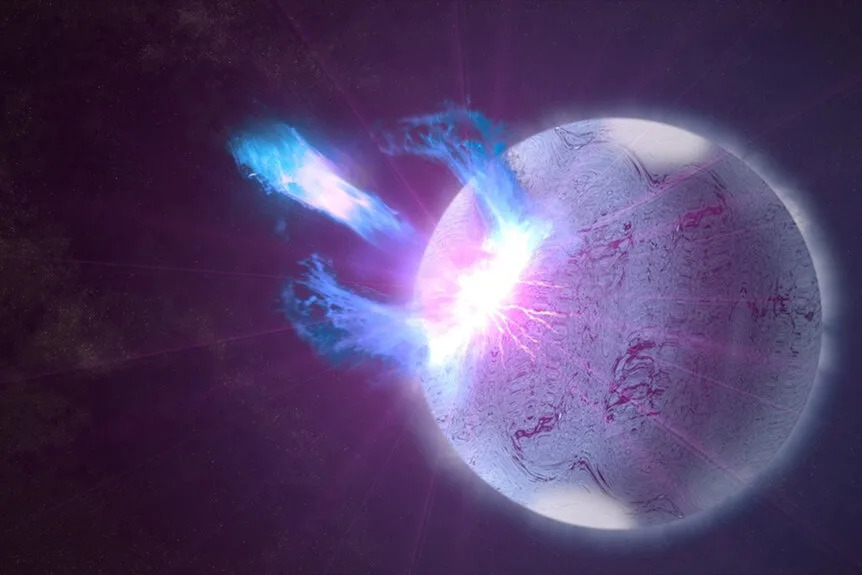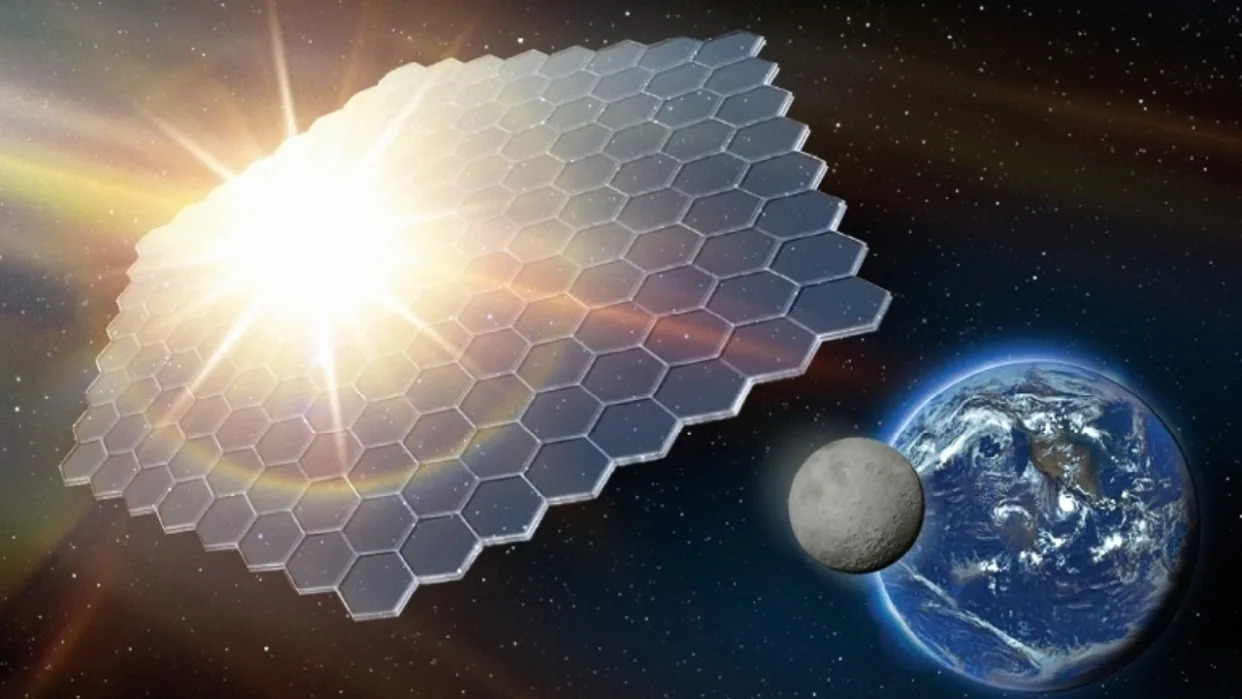Robert Lea
Tue, December 19, 2023

An illustration shows mysterious fast radio bursts as they bombard Earth from deep space.
Astronomers watched 35 explosive outbursts from a rare repeating "fast radio burst" (FRB) as it shifted in frequency like a "cosmic slide whistle," blinking in a puzzling pattern never seen before.
FRBs are millisecond-long flashes of light from beyond the Milky Way that are capable of producing as much energy in a few seconds as the sun does in a year. FRBs are believed to come from powerful objects like neutron stars with intense magnetic fields — also called magnetars — or from cataclysmic events like stellar collisions or the collapse of neutron stars to form black holes. Complicating the FRB picture, a few FRBs are "repeaters" that flash from the same spot in the sky more than once, while the majority burst once and then vanish.
The team behind the new research used the SETI Institute's Allen Telescope Array (ATA) to study the highly active repeating FRB known as FRB 20220912A. As they watched the FRB over 541 hours (nearly 23 days), the team saw its bursts of radiation cover a wide range of frequencies in the radio wave region of the electromagnetic spectrum, which eventually developed into a fascinating pattern that astronomers had never seen before.
The new data could finally help unravel the mystery of where deep-space FRBs come from and why a small minority of these rapid and intense blasts of radiation repeat.
Related: Scientists detect fastest-ever fast radio bursts, lasting just 10 millionths of a second
"This work is exciting because it provides both confirmation of known FRB properties and the discovery of some new ones," lead study author Sofia Sheikh, a postdoctoral fellow at the SETI Institute, said in a statement. "We're narrowing down the source of FRBs, for example, to extreme objects such as magnetars, but no existing model can explain all of the properties that have been observed so far."
The findings were accepted for publication in the journal Monthly Notices of the Royal Astronomical Society, and a copy is available to read on arXiv.org.

The spectra of the fast radio burst FRB 20220912A, showing its shifts in frequency.
Patterns and chaos in fast radio bursts
Sheikh and colleagues found that the bursts of radiation from FRB 20220912A shifted down in frequency, and when converted to notes played on a xylophone, this shift sounded like a slide whistle's descending toot — a behavior that scientists had never seen before from an FRB. This also helped the team identify that there is a cutoff point for the brightness of bursts from FRB 20220912A, revealing how much of the overall cosmic signal rate this FRB is responsible for.
While there was a noticeable pattern in the frequency of FRB 20220912A's bursts, there was no clear pattern to how long these bursts lasted or how much time passed between them. This shows there is an inherent unpredictability in repeating FRBs.
RELATED STORIES
—Oldest radio-wave explosion ever found could be used to weigh the universe, astronomers say
—Strange radio bursts that outshine entire galaxies may come from colliding neutron stars, new study suggests
—The largest telescope on Earth is coming to hunt radio-waves from the early universe
In addition, the study demonstrated how SETI's ATA — a telescope designed to hunt for radio signals from potential alien intelligence — has an important contribution to make to the study of FRBs and, therefore, some of the universe's most extreme events and objects.
"It has been wonderful to be part of the first FRB study done with the ATA — this work proves that new telescopes with unique capabilities, like the ATA, can provide a new angle on outstanding mysteries in FRB science," Sheikh said.
These Bizarre Radio Signals from Deep Space Keep Getting Weirder
Cassidy Ward
SYFY
Tue, December 19, 2023

These Bizarre Radio Signals from Deep Space Keep Getting Weirder
If aliens are out there, zipping around the cosmos in their high-tech spacecraft, they’re being pretty quiet about it. If Harry Vanderspeigle (star of Resident Alien, streaming now on Peacock) and his buddies are saying anything, they must be using some communications technology we haven’t dreamed up yet.
For decades, scientists have been searching the skies for stray radio signals, hoping to pick up some sign that we aren’t alone in the universe. So far, we haven’t found any smoking phasers but astronomers have picked up some weird radio signals with origins unknown. Recently, one such fast radio burst (FRB) upped the weirdness level when it did something we’ve never seen an FRB do before.
Something Sent Repeating Fast Radio Bursts into Space for Months
Our knowledge and understanding of FRBs is still in its infancy. The fist FRB was discovered only in 2007, when astronomers were sifting through archival pulsar data. Since then, astronomers have identified hundreds of FRBs from points all over space, but we don’t precisely know what they are or what causes them.
RELATED: A Single Object Ripped Out Over 1,600 Fast Radio Bursts in Just a Few Days and No One Knows Why
What we do know is that FRBs are highly energetic, producing incredibly bright but brief flashes of light. The energy released from a single burst contains the combined power produced by the Sun in more than a day, all compacted into an instant. They are usually isolated events, which makes them difficult to study. You usually can’t plan to observe them and have to get lucky, but occasionally an FRB repeats, giving astronomers an opportunity to aim their telescopes.
Tue, December 19, 2023

These Bizarre Radio Signals from Deep Space Keep Getting Weirder
If aliens are out there, zipping around the cosmos in their high-tech spacecraft, they’re being pretty quiet about it. If Harry Vanderspeigle (star of Resident Alien, streaming now on Peacock) and his buddies are saying anything, they must be using some communications technology we haven’t dreamed up yet.
For decades, scientists have been searching the skies for stray radio signals, hoping to pick up some sign that we aren’t alone in the universe. So far, we haven’t found any smoking phasers but astronomers have picked up some weird radio signals with origins unknown. Recently, one such fast radio burst (FRB) upped the weirdness level when it did something we’ve never seen an FRB do before.
Something Sent Repeating Fast Radio Bursts into Space for Months
Our knowledge and understanding of FRBs is still in its infancy. The fist FRB was discovered only in 2007, when astronomers were sifting through archival pulsar data. Since then, astronomers have identified hundreds of FRBs from points all over space, but we don’t precisely know what they are or what causes them.
RELATED: A Single Object Ripped Out Over 1,600 Fast Radio Bursts in Just a Few Days and No One Knows Why
What we do know is that FRBs are highly energetic, producing incredibly bright but brief flashes of light. The energy released from a single burst contains the combined power produced by the Sun in more than a day, all compacted into an instant. They are usually isolated events, which makes them difficult to study. You usually can’t plan to observe them and have to get lucky, but occasionally an FRB repeats, giving astronomers an opportunity to aim their telescopes.

Magnetar Burst
A rupture in the crust of a highly magnetized neutron star, shown here in an artist's rendering, can trigger high-energy eruptions Photo: NASA's Goddard Space Flight Center/S. Wiessinger
That’s what happened in the fall of 2022, when astronomers detected FRB 20220912A, a highly active, repeating FRB. Astronomers used SETI’s Allen Telescope Array (ATA), a custom-built telescope array at the Hat Creek Observatory in California’s Cascade Mountains. The array is capable of observing in a wide range of frequencies and can even check out multiple targets at once.
Astronomers pointed the ATA at FRB 20220912A for a total of 541 hours over the course of several months and recorded 35 individual radio bursts. FRBs commonly drift from high to low frequencies over time, and this one was no exception, but astronomers noticed an additional characteristic they had never seen before. Each of the bursts had an unusual dropout in the middle frequencies which researchers described as sounding like a slide whistle when the data was translated to sound.
RELATED: NASA Prepping New Laser Communication System For Astronauts On Mars, The Moon
“This work is exciting because it provides both confirmation of known FRB properties and the discovery of some new ones. We’re narrowing down the source of FRBs, for example, to extreme objects such as magnetars, but no existing model can explain all of the properties that have been observed so far,” said lead author Dr Sofia Sheikh, in a statement.
As to the origin of FRBs, they could be alien broadcasts but let’s be honest… that’s an awful lot of power to burn just to say hello to your galactic neighbors. There’s likely a more mundane but still radical explanation. One popular hypothesis involves magnetars, highly magnetized neutron stars. Another involves the collision of two or more white dwarfs and the burst of energy which might be released in the aftermath. It’s probably definitely not alien communication, but there is no explanation of FRBs that doesn’t make the universe more interesting.
These scientists want to put a massive 'sunshade' in orbit to help fight climate change
Leonard David
Tue, December 19, 2023

An illustration showing a giant reflector in space above Earth, partially blocking the light from the sun.
A group has been formed to study and promote a space-based sunshade to help fend off global climate change.
The idea has been discussed for years, but the Planetary Sunshade Foundation is cranking out papers that support the concept and spotlight the practicality of the approach.
A planetary sunshade, the Foundation advises, could be the best solution for solar radiation management and should be viewed as a key part of global efforts to counter ongoing climate change on Earth.
A matter of degrees
Undoing the worst effects of climate change may well rest on three pillars: Emissions reduction, carbon dioxide removal and solar radiation management.
There is an international agreement to strive to keep the world's average temperature from rising above 1.5 degrees Celsius (2.7 degrees Fahrenheit) over current averages. But the cold fact is that the lower the average temperature increase, the lower the climate impacts.
That said, climate change researchers have reported that our planet may well cross 1.5°C in the next decade. In the meantime there are now increased incidents of extreme weather, trends in sea level rise, widespread fires, along with melting ice caps.
Coupled to these warning signs is political pressure to counter climate-change calamity.
Undoing the worst effects of climate change may well rest on three pillars: Emissions reduction, carbon dioxide removal and solar radiation management.
There is an international agreement to strive to keep the world's average temperature from rising above 1.5 degrees Celsius (2.7 degrees Fahrenheit) over current averages. But the cold fact is that the lower the average temperature increase, the lower the climate impacts.
That said, climate change researchers have reported that our planet may well cross 1.5°C in the next decade. In the meantime there are now increased incidents of extreme weather, trends in sea level rise, widespread fires, along with melting ice caps.
Coupled to these warning signs is political pressure to counter climate-change calamity.
Livable planet
Morgan Goodwin is the Executive Director of the Planetary Sunshade Foundation.
As for why the group is pursuing the initiative, Goodwin is clear that current decarbonization strategies are necessary, but they are insufficient for a livable planet.
Decarbonisation is the lessening of carbon dioxide emissions by way of utilizing low carbon power sources to attain a lower output of greenhouse gasses permeating Earth's atmosphere.
"To avoid the worst impacts of climate change, the world should rapidly phase out the use of fossil fuels, remove gigatons of carbon from the atmosphere, and limit the incoming solar radiation," Goodwin told Space.com. Of all the methods broached to reduce solar radiation, he said, the sunshade has many advantages deserving of investment in the concept.

a diagram showing how a shade in space could keep some solar radiation from reach Earth
Construction strategies
Touted as a "megastructure" in space, a sunshade would be installed at the Sun-Earth Lagrange-1 point. Once in place, it could reduce radiative forcing — the trapping of heat in the atmosphere due to greenhouse gas emissions — by reflecting sunlight back into space.
The foundation says that construction of a Planetary Sunshade is possible, drawing upon initial solar sail technology already flown. "The rapid technological progress of space launch systems has resulted in the cost of sending materials and people into space dropping fast, changing the scope of what is possible."
According to the foundation, there are two possible sunshade construction strategies.
"We are pursuing both options, and think that if a planetary sunshade is built, the initial phases of construction will be an Earth-launched architecture while the later phases will use space resources and in-space construction," the group's website explains.

a silver kite-like sail in space
Hands-off Mother Nature?
But there are those that hold tight onto the belief: "You shouldn't fool with Mother Nature!"
Goodwin responds by pointing out that humans are messing with Mother Nature at a grand scale through state-sanctioned and often state-subsidized industrial practices.
"Our survival as a civilization depends on our ability to wisely and intentionally change how we interact with our planet," said Goodwin.
Indeed, in the past year, the White House published a congressionally mandated report on geoengineering governance pathways, Goodwin said, a document that takes "a small but solid step forward," he added, into creating a framework for further investment in geoengineering research.

a diagram showing various techniques of mitigating solar radiation
Report takeaways
In June of this year, the White House Office of Science and Technology Policy released the Congressionally-mandated report on solar radiation modification.
As for report takeaways it cautions that any potential comprehensive research program must encompass the societal as well as the scientific dimensions of solar radiation modification.
The document highlights several key priority areas for further solar radiation modification research, including determining climate and environmental impacts of solar radiation modification deployment; assessing potential societal outcomes and ecological consequences; and the need to examine how research might be done in cooperation among international partners.
That report also acknowledges that research on solar radiation modification impacts to date has been ad hoc and fragmented, rather than being the product of a comprehensive strategy. As a result, substantial knowledge gaps and uncertainties exist in many critical areas.
In June of this year, the White House Office of Science and Technology Policy released the Congressionally-mandated report on solar radiation modification.
As for report takeaways it cautions that any potential comprehensive research program must encompass the societal as well as the scientific dimensions of solar radiation modification.
The document highlights several key priority areas for further solar radiation modification research, including determining climate and environmental impacts of solar radiation modification deployment; assessing potential societal outcomes and ecological consequences; and the need to examine how research might be done in cooperation among international partners.
That report also acknowledges that research on solar radiation modification impacts to date has been ad hoc and fragmented, rather than being the product of a comprehensive strategy. As a result, substantial knowledge gaps and uncertainties exist in many critical areas.
Uncertainties, risks, challenges
Earlier this year, the Global Commission on Governing Risks from Climate Overshoot (the "Climate Overshoot Commission") issued their report.
This independent group of global leaders recommended a strategy to reduce risks should global warming goals be exceeded, that is a "climate overshoot" that crosses the 1.5 °C threshold.
In the commission report, they broached space-based reflectors; stratospheric aerosol injection, cirrus cloud thinning and marine cloud brightening — all solar Radiation Modification (SRM) techniques.
"But SRM would counter climate change imperfectly and poses serious uncertainties, risks, and governance challenges," the commission study reported.
"The governance gaps for SRM are the most acute," that reported said. "How can it be researched and evaluated without distracting from essential reductions of greenhouse gas emissions? Who decides whether to undertake SRM and under which conditions? How could countries' differences on this question be resolved?"
Goodwin of the Planetary Sunshade Foundation concludes that this year will close as the hottest year ever recorded, replacing 2022 which in turn took that title from 2021. "As the rate and impacts of warming increase, more and more tactics and perspectives will be brought to the table."
Whether or not a sun-deflecting, "made-in-the-shade" sail remains a bright prospect on that discussion table is yet to be determined.
No comments:
Post a Comment